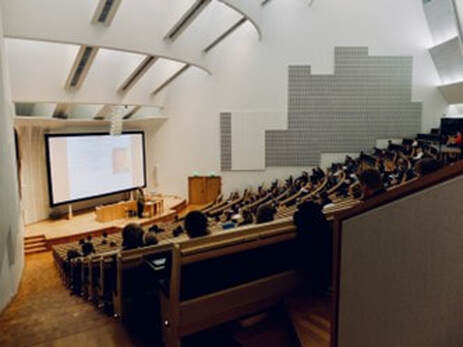|
By Trinity Vey It’s widely recognized that STEM professions are traditionally white cis male-dominated. Women and racial minorities in these professions continue to be underrepresented and face discrimination at micro and macro levels. As such, it probably doesn’t come as a big surprise that sexual and gender minority groups are also statistically underrepresented in STEM fields and face systemic inequities. This blog is part one of a mini-series and will be highlighting some of the current data regarding the experiences of LGBTQ+ people in STEM. Subsequent blogs in this series highlight some examples of LGBTQ+ role models in STEM as well as some ways we might improve the numbers and experiences of LGBTQ+ people in STEM fields. Before we can solve the problem, we must first acknowledge and measure it; unfortunately, data on this topic is limited. Research has been mostly done in the US, and generalizations are often based on the entire LGBTQ+ community, rather than data representing specific identities. Throughout this blog, the acronym LGBTQ+ will be used to refer to people belonging to gender and sexual identity minority groups, including but not limited to lesbian, gay, bisexual, transgender, queer, non-binary, and two-spirit people. LGBTQ+ disparities in STEM education The trajectory towards a career in STEM begins with education. At each level of education and across early professional stages required for achieving a STEM career, there is an increasing loss of minority groups – a concept known as the “leaky pipeline.” The first indication that LGBTQ+ people are part of the leaky pipeline is that LGBTQ+ students are less likely than non-LGBTQ+ students to major in STEM fields. For those that do choose to enter STEM fields, there are also issues with retention. A study published in 2018 found that compared to heterosexual students, sexual minority students are more likely to leave STEM for non-STEM fields. This is surprising, as sexual minority students are also more likely to be involved in undergraduate research – which is generally a contributor to STEM retention. This discrepancy in retention is thus thought to be due to the climate and culture of STEM, rather than academic factors. Unfortunately, there are many non-academic-related challenges that LGBTQ+ students are more likely to face compared to non-LGBTQ+ peers throughout their education. One discouraging example is that LGBTQ+ university students experience higher levels of sexual assault and misconduct than non-LGBTQ+ students. LGBTQ+ disparities in the STEM workforce LGBTQ+ people who do remain in a STEM-focused education unfortunately are more likely to have negative experiences in the workforce. Research published in 2021 found that compared to non-LGBTQ+ colleagues, LGBTQ+ professionals in STEM were more likely to report exclusion at work and fewer career opportunities. Compared to their non-LGBTQ+ counterparts, LGBTQ+ professionals were 22% more likely to feel nervous or stressed about work, in addition to thinking about leaving their job and the STEM field as a whole. These findings are thought to be a result of LGBTQ+ people experiencing high rates of marginalization, career limitations, and devaluation at work. Within academia, up to 70% of sexual-minority faculty members who are out at work reported feeling uncomfortable in their department. Alarmingly, a UK study reported that 32% of trans and non-binary people in the physical sciences experienced exclusionary, intimidating, offensive, or harassing behaviour in the workplace because of their identity. These findings only begin to scratch the surface of the experiences of LGBTQ+ people globally. Unfortunately, these negative experiences can be amplified for individuals belonging to multiple minority groups. LGBTQ+ people of colour or LGBTQ+ identifying women are more likely to experience professional devaluation or harassment at work than white or male LGBTQ+ counterparts. Woman with book over her face, frustrated. Credit: Siora Photography, from Unsplash. Challenging systemic issues There are likely a multitude of factors that contribute to negative issues for people belonging to gender and sexual minority groups in STEM fields. In addition to explicit bias and discrimination, a heteronormative culture reinforces gender role stereotypes within STEM. Apolitical, binary, objective thinking perpetuates in STEM fields today, which can prevent people from feeling comfortable disclosing details regarding their personal lives and identity and contributes to social isolation. Furthermore, having mentors and role models in STEM is important to build confidence and a sense of belonging. As LGBTQ+ identity is often not visibly apparent, and many are not encouraged to share their identity in the workplace, finding role models can be a challenge for LGBTQ+ youth and students. How many openly LGBTQ+ people can you think of in your own school or workplace? With more diverse teams comes richer and more innovative problem-solving. It’s clear that there's much work to be done to establish supportive and welcoming STEM environments for everyone. In upcoming blogs in this series, we will highlight some LGBTQ+ role models and changemakers in STEM, as well as some ways we can work towards an increase in the retention of LGBTQ+ people in STEM moving forwards. The hope is that we can eventually create environments in STEM where all people feel comfortable sharing and celebrating their identities. Pride parade, with rainbow flags. Credit: Margaux Bellott, from Unsplash References:
0 Comments
Your comment will be posted after it is approved.
Leave a Reply. |
LIFESTYLE BLOGRead our lifestyle advice, written exclusively for pre-professional women in science and engineering. From advice about fashion, work and family balance, self, wellness, and money, we've got you covered! |
The Scientista Foundation, Inc. All Rights Reserved © 2011-2021 | Based in NY | contact@scientistafoundation.org
The Network for Pre-Professional Women in Science and Engineering
The Scientista Foundation is a registered 501(c)(3) -- Donate!
The Network for Pre-Professional Women in Science and Engineering
The Scientista Foundation is a registered 501(c)(3) -- Donate!




